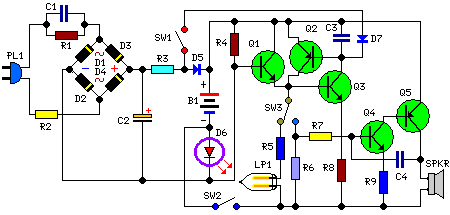
Home security alarm system circuit diagram
.png)
Have you ever considered implementing your own home security alarm system? It is one of the simplest and most interesting circuits for electronics beginners. The new home security equipment utilizes a Light Dependent Resistor (LDR) to detect security breaches. A theft attempt and other security threats can be monitored with this straightforward circuit, enhancing security systems. This project is also well-suited for school students working on high school science projects. To implement this alarm system for home use, an optical path must be established using LASER beams around the premises. The LASER path is created with one LASER torch and three mirror arrangements that enclose the entire area. The project arrangement section below provides guidance on creating this optical (light) path. The home security system is explained in detail with animation and simulation. The voltage drop across the LDR remains low (V=IR according to Ohm's law), which is insufficient to turn on the transistor, keeping it in the OFF state. When an individual (e.g., a thief) obstructs the continuous flow of the LASER beam, the light incident on the LDR is blocked. Consequently, its resistance increases significantly, reaching values in the megaohm range (according to Ohm's law V=IR). As resistance increases, the voltage drop also rises; when this voltage drop exceeds the cut-in voltage of the silicon NPN transistor (0.6V; BC547), the transistor will turn ON. For a visual representation, an animated demonstration of the home security alarm circuit is provided below. An LED is used in place of a buzzer for the animated demonstration.
The home security alarm system described utilizes a basic yet effective circuit design that is ideal for beginners in electronics. The core component of this system is the LDR, which serves as a light-sensitive resistor. The circuit operates by continuously monitoring the light intensity of the LASER beam that is projected around the perimeter of the area to be secured.
The LASER torch emits a beam that is reflected by three strategically placed mirrors, creating a closed optical path. This arrangement ensures that the beam covers the entire area without gaps. Under normal conditions, the uninterrupted LASER beam keeps the LDR in a low-resistance state, resulting in a minimal voltage drop across it. This low voltage is insufficient to activate the transistor, which remains in the OFF state, preventing any alarm signal from being generated.
When an intruder crosses the LASER beam, the light incident on the LDR is obstructed, causing the resistance of the LDR to increase dramatically. This increase in resistance leads to a corresponding rise in voltage drop across the LDR. Once this voltage exceeds the threshold of approximately 0.6V, the NPN transistor (such as the BC547) switches to the ON state. This transition allows current to flow through the connected load, which could be an LED or a buzzer, effectively signaling a security breach.
This electronic circuit can be implemented on a breadboard for prototyping and testing purposes. The simplicity of the design makes it an excellent project for students, providing hands-on experience with fundamental concepts in electronics, including Ohm's law, transistor operation, and light sensing technologies. Additionally, the use of animation and simulation aids in understanding the functionality of the circuit, making it an engaging learning tool.Have you ever thought aboutimplementing your own home security alarm systems It`s one of the simplest and interesting circuits for electronic beginners. Our new home security equipment uses aLDR (Light Depended Resistor) to detect security problems. Theft attempt and other security threats can be controlled by using this simple circuit to improve yoursecurity systems. This is also best suited for school students for their high school science projects. To implement this alarm system for home, you have to provide an optical path (with LASER beams) around your home. The LASER path is made possible with one LASER torch and 3 mirror arrangements which encloses the whole area.
Please refer the project arrangement section below to make this optical (light) path. We have explained about home security system in detail with animation/ simulation. Thus the voltage drop across the LDR is also low [V=IR (Ohm`s law)] which is insufficient to turn ON the transistor, so the transistor remains in OFF state. When a person (eg: thief) makes a block to the continuous flow of LASER beam, then the light falling on the LDR gets blocked.
Thus its resistance increases to a high value in the order of M © range (According to Ohm`s law V=IR). While resistance increases the voltage drop also increases, when this voltage drop exceeds the cut in voltage of the silicon NPN transistor (0.
6V; BC547), it will turn ON. To realize the concept we are providing animation/ simulation of home security alarm circuit below. For animated demonstration, LED is used instead of buzzer. 🔗 External reference
The home security alarm system described utilizes a basic yet effective circuit design that is ideal for beginners in electronics. The core component of this system is the LDR, which serves as a light-sensitive resistor. The circuit operates by continuously monitoring the light intensity of the LASER beam that is projected around the perimeter of the area to be secured.
The LASER torch emits a beam that is reflected by three strategically placed mirrors, creating a closed optical path. This arrangement ensures that the beam covers the entire area without gaps. Under normal conditions, the uninterrupted LASER beam keeps the LDR in a low-resistance state, resulting in a minimal voltage drop across it. This low voltage is insufficient to activate the transistor, which remains in the OFF state, preventing any alarm signal from being generated.
When an intruder crosses the LASER beam, the light incident on the LDR is obstructed, causing the resistance of the LDR to increase dramatically. This increase in resistance leads to a corresponding rise in voltage drop across the LDR. Once this voltage exceeds the threshold of approximately 0.6V, the NPN transistor (such as the BC547) switches to the ON state. This transition allows current to flow through the connected load, which could be an LED or a buzzer, effectively signaling a security breach.
This electronic circuit can be implemented on a breadboard for prototyping and testing purposes. The simplicity of the design makes it an excellent project for students, providing hands-on experience with fundamental concepts in electronics, including Ohm's law, transistor operation, and light sensing technologies. Additionally, the use of animation and simulation aids in understanding the functionality of the circuit, making it an engaging learning tool.Have you ever thought aboutimplementing your own home security alarm systems It`s one of the simplest and interesting circuits for electronic beginners. Our new home security equipment uses aLDR (Light Depended Resistor) to detect security problems. Theft attempt and other security threats can be controlled by using this simple circuit to improve yoursecurity systems. This is also best suited for school students for their high school science projects. To implement this alarm system for home, you have to provide an optical path (with LASER beams) around your home. The LASER path is made possible with one LASER torch and 3 mirror arrangements which encloses the whole area.
Please refer the project arrangement section below to make this optical (light) path. We have explained about home security system in detail with animation/ simulation. Thus the voltage drop across the LDR is also low [V=IR (Ohm`s law)] which is insufficient to turn ON the transistor, so the transistor remains in OFF state. When a person (eg: thief) makes a block to the continuous flow of LASER beam, then the light falling on the LDR gets blocked.
Thus its resistance increases to a high value in the order of M © range (According to Ohm`s law V=IR). While resistance increases the voltage drop also increases, when this voltage drop exceeds the cut in voltage of the silicon NPN transistor (0.
6V; BC547), it will turn ON. To realize the concept we are providing animation/ simulation of home security alarm circuit below. For animated demonstration, LED is used instead of buzzer. 🔗 External reference





